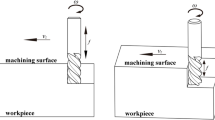Abstract
This investigation represented a fundamental research on the potential effects of the ultrasonic on the tool wear involved in rotary ultrasonic machining (RUM) of glass BK7 process. Comparative examinations of the profile deviations and abrasive morphologies of the two diamond tools produced with and without ultrasonic were conducted with optical microscopy, 3-D optical profiler, and scanning electron microscopy (SEM), and their resultant effects on the dimension accuracy and the surface quality of the machined component were also explored. Giving consideration to the strain rate effects of the material provoked by the ultrasonic superposition, the split Hopkinson pressure bar (SHPB) experiments were employed to validate their effects on the dynamic mechanical properties of glass BK7. Afterward, the active mechanisms of abrasive splitting were investigated theoretically. It was found that the ultrasonic superposition by means of suppressing the abrasive dislodgments reduced the profile deviation of the diamond tool, hereby improving the dimensional accuracy of the component. Furthermore, superimposing an ultrasonic vibration would prolong the service life of the abrasives, and this wear-resistant capacity would increase the amount of the working abrasives, thus improving the specimen surface quality. The morphological observations of the abrasives revealed that ultrasonic superposition led to the splitting characteristics converted from transgranular cracking (macrosplintering) to conchoidal fracture (microsplintering). The dynamic mechanical properties of glass BK7 would increase its Young’s modulus, which would reduce the crack nucleation depth in the abrasive, leading the conversion of the splitting appearances.
Similar content being viewed by others
References
Hu P, Zhang JM, Pei ZJ (2002) Modeling of material removal rate in rotary ultrasonic machining: designed experiments. J Mater Process Technol 129(1):339–344
Marinescu ID, Hitchiner MP, Uhlmann E (2006) Handbook of machining with grinding wheels. CRC Press
Spur G, Holl SE (1996) Ultrasonic assisted grinding of ceramics. J Mater Process Technol 62(4):287–193
Uhlmann E, Spur G (1998) Surface formation in creep feed grinding of advanced ceramics with and without ultrasonic assistance. CIRP Ann-Manuf Technol 47(1):249–252
Ishikawa K, Suwabe H, Nishide T (1998) A study on combined vibration drilling by ultrasonic and low-frequency vibrations for hard and brittle materials. Precis Eng 22(4):196–205
Zeng WM, Li ZC, Pei ZJ (2005) Experimental observation of tool wear in rotary ultrasonic machining of advanced ceramics. Int J Mach Tools Manuf 45(12):1468–1473
Lv D, Wang H, Tang Y (2013) Influences of vibration on surface formation in rotary ultrasonic machining of glass BK7. Precis Eng 37(4):839–848
Malkin S, Hwang TW (1996) Grinding mechanisms for ceramics. CIRP Ann-Manuf Technol 45(2):569–580
Lv D, Huang Y, Wang H (2013) Improvement effects of vibration on cutting force in rotary ultrasonic machining of BK7 glass. J Mater Process Technol 213(9):1548–1557
Haney EJ, Subhash G (2011) Static and dynamic indentation response of basal and prism plane sapphire. J Eur Ceram Soc 31(9):1713–1721
Dally JW, Barker DB (1988) Dynamic measurements of initiation toughness at high loading rates. Exp Mech 28(3):298–303
Lv D, Huang Y, Tang Y (2013) Relationship between subsurface damage and surface roughness of glass BK7 in rotary ultrasonic machining and conventional grinding processes. Int J Adv Manuf Technol 67(1–4):613–622
Wang Z (2008) Study on the detection and control techniques of subsurface damage in optical fabrication (Ph.D. dissertation). National University of Defense Technology (in Chinese)
Liang Z, Wang X, Wu Y (2012) An investigation on wear mechanism of resin-bonded diamond wheel in elliptical ultrasonic assisted grinding (EUAG) of monocrystal sapphire. J Mater Process Technol 212(4):868–876
Johnson KL (1987) Contact mechanics. Cambridge university press
Wang Z, Wu Y, Dai Y (2008) Subsurface damage distribution in the lapping process. Appl Opt 47(10):1417–1426
Lv D, Tang Y, Wang H (2013) Experimental investigations on subsurface damage in rotary ultrasonic machining of glass BK7. Mach Sci Technol 17(3):443–463
Author information
Authors and Affiliations
Corresponding author
Rights and permissions
About this article
Cite this article
Lv, D. Influences of high-frequency vibration on tool wear in rotary ultrasonic machining of glass BK7. Int J Adv Manuf Technol 84, 1443–1455 (2016). https://doi.org/10.1007/s00170-015-7204-1
Received:
Accepted:
Published:
Issue Date:
DOI: https://doi.org/10.1007/s00170-015-7204-1




